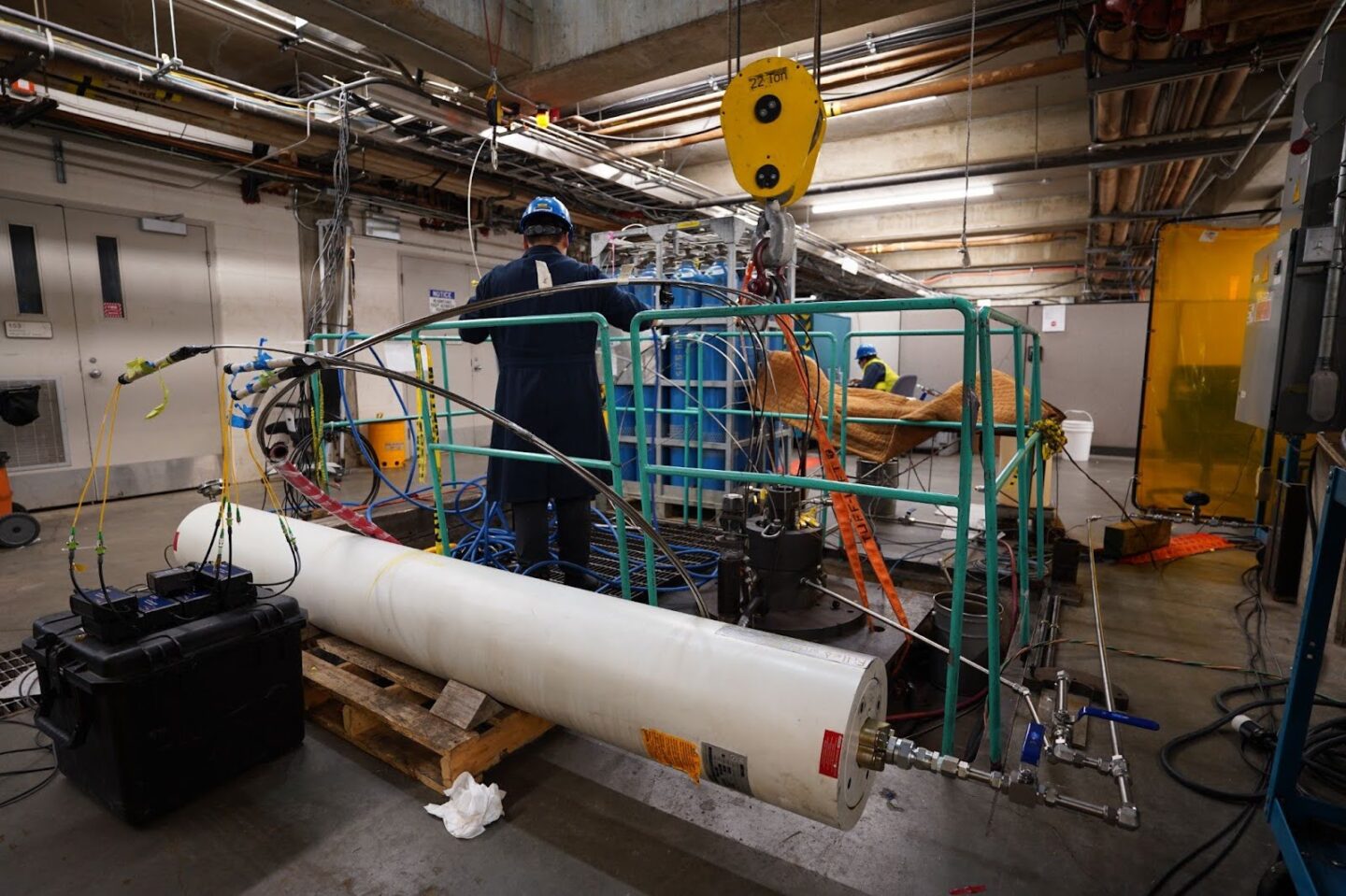Energy supply and demand can drastically change across seasons, geography, and in response to various extremes like heatwaves or floods. Storing excess energy underground when demand is low and extracting the extra resources when demand is high can help balance these supply and demand changes, while simultaneously helping to keep energy affordable and reliable. As the world’s leading natural gas producer, the U.S. has decades of experience storing gas in depleted underground reservoirs, oil and gas fields, and engineered salt caverns, using wells to pump the resource to the surface. Ensuring the safety and functionality of these wells over many years under dynamic stresses and conditions such as extreme weather or periods of high energy demand remains a critical need.
EESA scientists are working to develop distributed fiber optic sensing (DFOS), a technology that uses tiny fibers to monitor the conditions of structures and materials, as an effective way to monitor the safe operation of underground gas storage wells (UGS). Their study, published in the Institute of Electronics and Engineers’ journal, provides a valuable reference for future well monitoring and field tests, showing how this technology can advance the reliability and safety of underground natural gas storage and extraction.
“DFOS could move our underground energy systems to a future in which we respond to disruptions and issues proactively, as opposed to reactively.” – Linqing Luo
The need for DFOS in subsurface energy storage
Gas leaks from UGS wells, which can develop from aging infrastructure and natural disasters like earthquakes or floods, can release toxic substances to the atmosphere and environment, posing public and environmental health risks while also disrupting energy supply. Current strategies to investigate well systems require the well to stop operating, leading to a decrease in local energy supply. Existing monitoring methods rely on periodic inspections which can miss small changes deep underground that indicate potential safety or operational issues.
DFOS pulses light through tiny fibers that backscatter to reveal information about the physical conditions of the structure or material they are attached to. With the capability to provide continuous data about temperature, strain, and vibrations–all factors that can help indicate the condition of UGS wells–this method of monitoring has shown promising potential to autonomously capture real-time information about well systems essential for meeting energy demand.
“Fiber optic sensing can capture minute changes in the physical conditions of a structure, and sends them in real time to your laptop for autonomous, continuous system status monitoring” said EGD Staff Scientist Yuxin Wu, a senior author of the study. “Using this technology for monitoring natural gas wells could capture data indicative of wellbore conditions, allowing proactive maintenance to avoid safety issues. It could transform the reliability of our nation’s UGS system, and help reduce catastrophic events that stem from these leaks.”
A new cable with more effective data collection
To validate DFOS under realistic conditions, the researchers designed a fiber optic cable that can withstand harsh environmental conditions and monitor both the strain and temperature of the “downhole,” or underground part of the well system. Unlike conventional systems that require separate fibers and installations to monitor temperature and stress, this novel cable integrates both sensing functions, reducing installation complexity and cost.

Part of the well system being tested with fiber optic sensing cables attached to monitor its physical conditions. Photo credit: Linqing Luo
The study took place in a lab setting, where the fiber optic cables were installed on a mock UGS well–a well designed specifically to be tested–simulating similar pressure, stress, and temperature conditions to the field.
The 80-foot long well system was built with engineered defects in order to test the ability of the fiber-optic sensing to detect problems. This allowed the researchers to sufficiently collect information about the conditions of the well that would otherwise be invisible from the surface.
“This new technology and research represents a significant step forward in modernizing how we monitor and manage underground gas storage,” said EGD Research Scientist Linqing Luo, lead author of the publication. “DFOS could move our underground energy systems to a future in which we respond to disruptions and issues proactively, as opposed to reactively.”
Building more efficient, reliable energy infrastructure
The sensing technology was able to capture minute changes in strain, detect low concentrations of leaks, and monitor variations in temperature along the system. The newly designed cable also showed to be durable, withstanding extreme pressure conditions and repeated injection-withdraw cycles without wear or impacts to data collection.
These results demonstrated that DFOS shows promising potential for wellbore operation monitoring and early detection of leaks and other operational issues, and could be a viable option for UGS monitoring going forward.
“The next step is testing DFOS in the field, and in deeper well systems, to capture its efficiency in a more realistic setting. We are already doing that with Pacific Gas & Electric (PG&E), a large UGS operator in the U.S.,” Wu said.
The team is collaborating PG&E to take the experiment from the lab to the field, and validate DFOS using actual production wells. This will help scientists better understand the practicality of this technology outside of a lab setting–bringing this monitoring strategy one step closer to reality.
Shedding light on DFOS as a transformative tool to help “see the unseen” when it comes to UGS wells, the findings of this study could be applied to other energy production and storage systems involving underground storage and wells, such as geothermal energy and oil and gas. The ability to provide real-time, continuous, and autonomous monitoring of well systems—potentially preventing issues before they even occur–could transform the safety, efficiency, and reliability of the nation’s underground energy storage systems.
With the possibility of making uninterrupted energy supply more realistic, especially in the face of aging infrastructure and sporadic demand, this study lays the groundwork for new standards in subsurface monitoring that could strengthen both energy resilience and environmental and public health.


